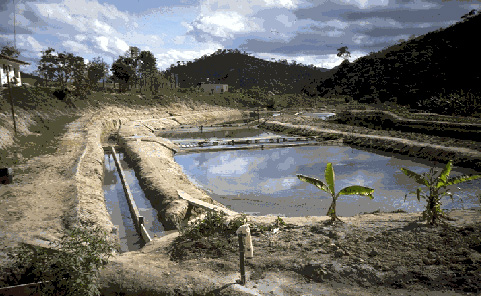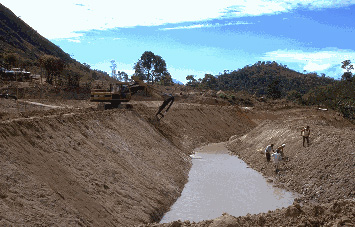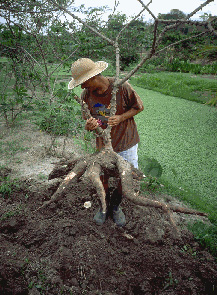Deep fish ponds are constructed after algae ponds for production of diverse fish species. The large water volume also extends retention time of wastewater.
A complex series of natural processes occurs here:
- algae from the algae basin are consumed by fish & zoo-plankton
- different fish live at different trophic levels, i.e. at different depths using different feed sources
- fish produce waste which is mineralized and acts as a nutrient for macrophytes
- BOD is reduced through microorganisms and photosynthesis
- organic material is mineralized
- pathogens are eliminated by sunlight, retention time, and micro-organic processes.
 Photo: Newly constructed site. Inlet far lower left. Algae basin with divider wall, left. Oxygenation ponds center. Fish pond far right. Dikes are starting to be planted with fruit trees and crops. In three months the site is covered with vegetation. See photo below for pond depth and slope during construction, plus bottom page 24 for photo of site several months later.
Photo: Newly constructed site. Inlet far lower left. Algae basin with divider wall, left. Oxygenation ponds center. Fish pond far right. Dikes are starting to be planted with fruit trees and crops. In three months the site is covered with vegetation. See photo below for pond depth and slope during construction, plus bottom page 24 for photo of site several months later.
- Ponds are 2.5 - 3 meters deep, usually one meter below ground level and two meters above. They are dimensioned as rectangles normally 50 - 150 meters long and 20 meters wide. The width is to allow easier harvesting of fish.
- These need an emergency outlet pipe to allow water overflow into the drainage ditch or nearby channel. This pipe must also be constructed in a way that it does not leak. Leakage could destabilize dykes and disrupt water flow.
- Soil from pond excavation is used to build up dyke walls. Wherever possible, a bulldozer is used for this, but backdiggers and manual labor are also feasible.
- To determine the depth of ponds and slope of dykes, string and stakes should be used to guide workers/machinery during the construction process. Measurements of depth are taken every hour on the pond sites once it is seen that the workers are approaching the one meter depth of pond bottoms and two meter height of dykes.
- Dykes are extremely important for growing crops. They absorb nutrients from water, and also use pond water for passive irrigation. These dykes are the most productive agricultural part of the system. Careful attention is required to what and how crops are planted, plus relationship to pond water level.
 Photo: Construction of a deep fish pond on a very steep incline. Once planted, the pond dikes prevent erosion. This contributes to flood prevention. Note also slope of pond walls. Petropolis, Brazil.
Photo: Construction of a deep fish pond on a very steep incline. Once planted, the pond dikes prevent erosion. This contributes to flood prevention. Note also slope of pond walls. Petropolis, Brazil.
Macrophyte ponds
- These hold several varieties of water-based plants macrophytes to absorb phosphates, nitrates, ammonia and potassium. They extend retention time and eliminate pathogens through microbiological processes especially in the root zones of the macrophytes, and through exposure to sunlight.
- The ponds are up to 70 cm deep and no more than 5 meters wide. This width simplifies macrophyte harvesting. Deeper ponds cause inefficient water treatment because water passes below the treatment zones of the macrophyte roots.
- Ponds vary in length between 25 and 150 meters. Sometimes ponds are divided into tanks to allow production of different types of macrophytes. These are separated by gates.
- If no such gates are anticipated, floating barriers of wood or bamboo are used to divide ponds into sections to prevent macrophytes from drifting towards one end of the pond with wind.
- It is advised to construct overflow barriers when pond length exceeds 50 m to ensure proper water flow through the ponds and avoid short circuits.
 On each side of the macrophyte ponds, flat-topped dykes are constructed to absorb water from the ponds for passive irrigation. As with dykes surrounding the fish ponds, these are the most productive aspects of the site. Therefore they require special construction attention, including replacing their topsoil after construction is completed to maximize soil fertility.
On each side of the macrophyte ponds, flat-topped dykes are constructed to absorb water from the ponds for passive irrigation. As with dykes surrounding the fish ponds, these are the most productive aspects of the site. Therefore they require special construction attention, including replacing their topsoil after construction is completed to maximize soil fertility.
Photo: Site operator harvests large manioc root on dyke passively irrigated by nutrient rich water from Macrophyte pond, located behind him. Rapid growth rates are a defining characteristic of these sites. Silva Jardim, Brazil
